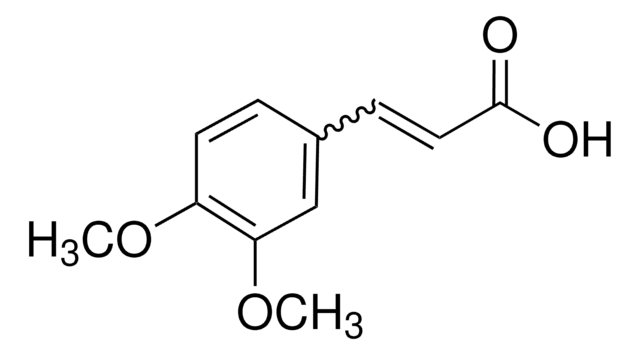All Photos(1)
About This Item
Linear Formula:
CF3C6H4CH=CHCO2H
CAS Number:
Molecular Weight:
216.16
MDL number:
UNSPSC Code:
12352100
PubChem Substance ID:
NACRES:
NA.22
Recommended Products
Assay
99%
form
solid
mp
231-233 °C (lit.)
SMILES string
OC(=O)\C=C\c1ccc(cc1)C(F)(F)F
InChI
1S/C10H7F3O2/c11-10(12,13)8-4-1-7(2-5-8)3-6-9(14)15/h1-6H,(H,14,15)/b6-3+
InChI key
ANRMAUMHJREENI-ZZXKWVIFSA-N
Application
trans-4-(Trifluoromethyl)cinnamic acid has been employed as internal standard for the determination of A77 1726 (2-cyano-3-hydroxy-N-[4-(trifluoromethyl)phenyl]-2-butenamide) in plasma by HPLC.
Signal Word
Warning
Hazard Statements
Precautionary Statements
Hazard Classifications
Eye Irrit. 2 - Skin Irrit. 2 - STOT SE 3
Target Organs
Respiratory system
Storage Class Code
11 - Combustible Solids
WGK
WGK 3
Flash Point(F)
Not applicable
Flash Point(C)
Not applicable
Personal Protective Equipment
dust mask type N95 (US), Eyeshields, Gloves
Certificates of Analysis (COA)
Search for Certificates of Analysis (COA) by entering the products Lot/Batch Number. Lot and Batch Numbers can be found on a product’s label following the words ‘Lot’ or ‘Batch’.
Already Own This Product?
Find documentation for the products that you have recently purchased in the Document Library.
Customers Also Viewed
Petra Bohanec Grabar et al.
Drug metabolism and disposition: the biological fate of chemicals, 37(10), 2061-2068 (2009-07-08)
Leflunomide is a disease-modifying antirheumatic drug used for the treatment of rheumatoid arthritis (RA). Cytochromes P450, mainly CYP1A2 and CYP2C19, may be involved in the transformation of leflunomide to leflunomide metabolite (A77 1726, 2-cyano-3-hydroxy-N-[4-(trifluoromethyl)phenyl]-2-butenamide). The aim of this study was
Noah D Bronstein et al.
ACS nano, 13(4), 3839-3846 (2019-03-12)
We present a combined experimental and theoretical study of ligand-ligand cooperativity during X-type carboxylate-to-carboxylate ligand exchange reactions on PbS quantum dot surfaces. We find that the ligand dipole moment (varied through changing the substituents on the benzene ring of cinnamic
Our team of scientists has experience in all areas of research including Life Science, Material Science, Chemical Synthesis, Chromatography, Analytical and many others.
Contact Technical Service












